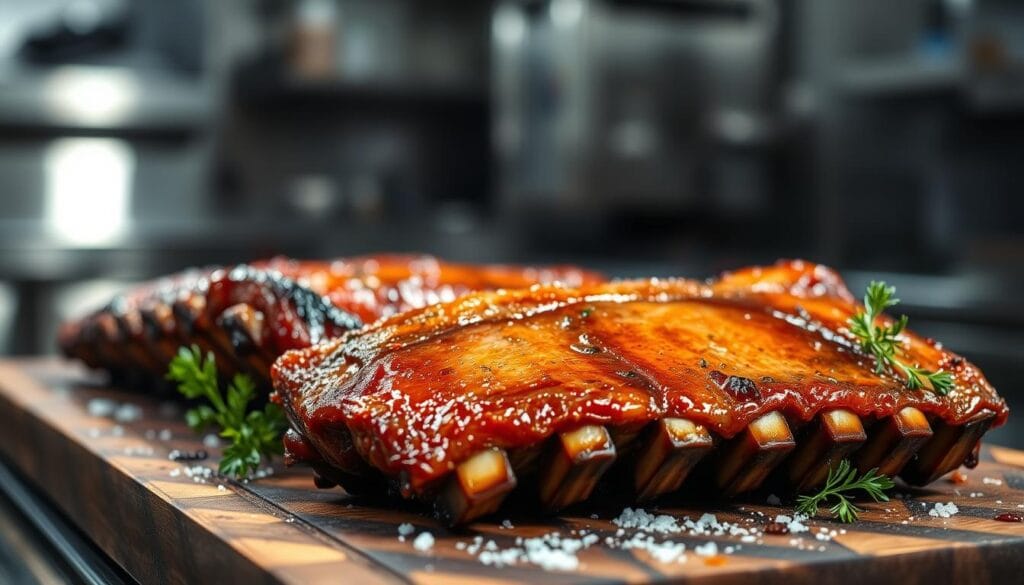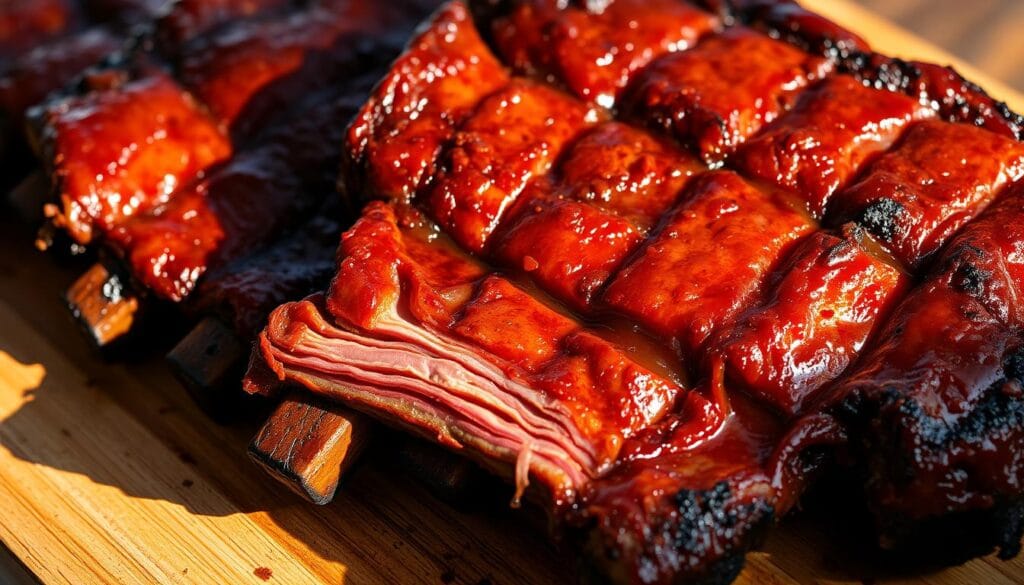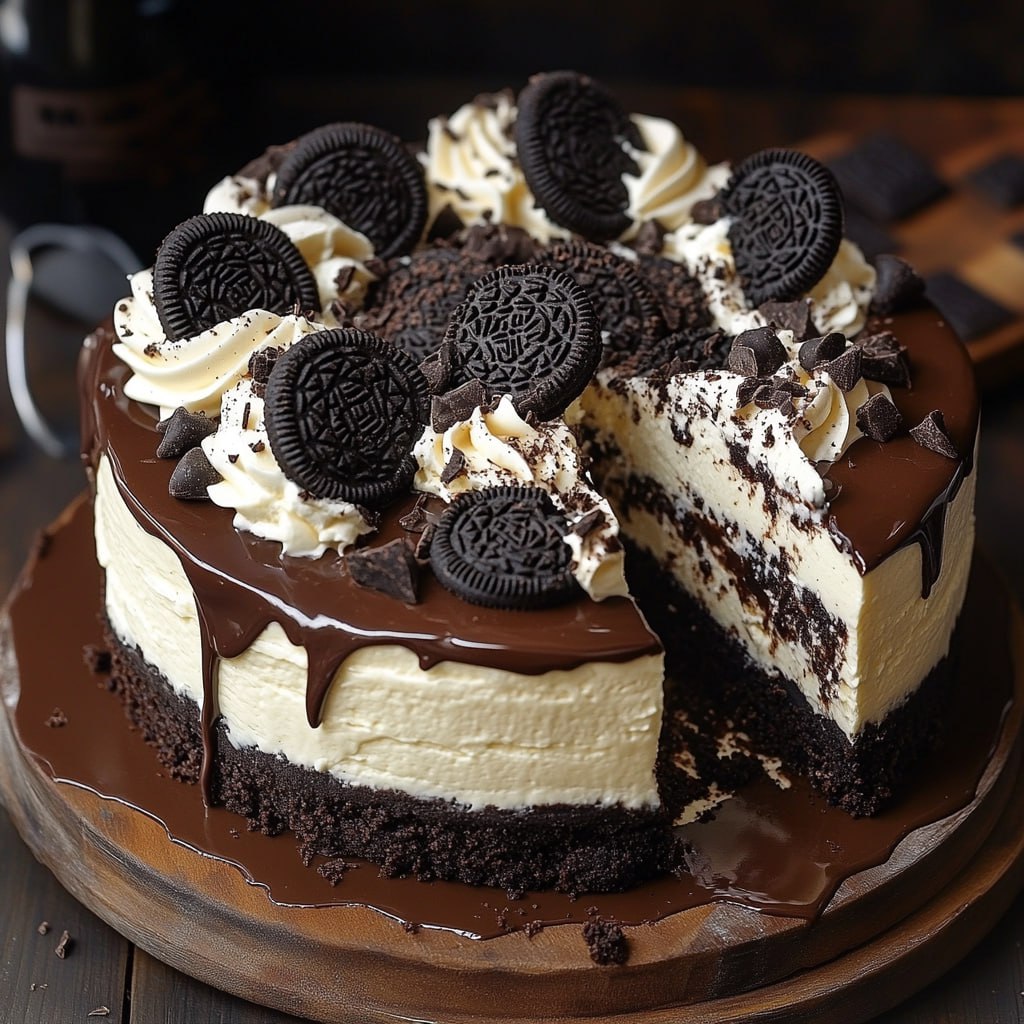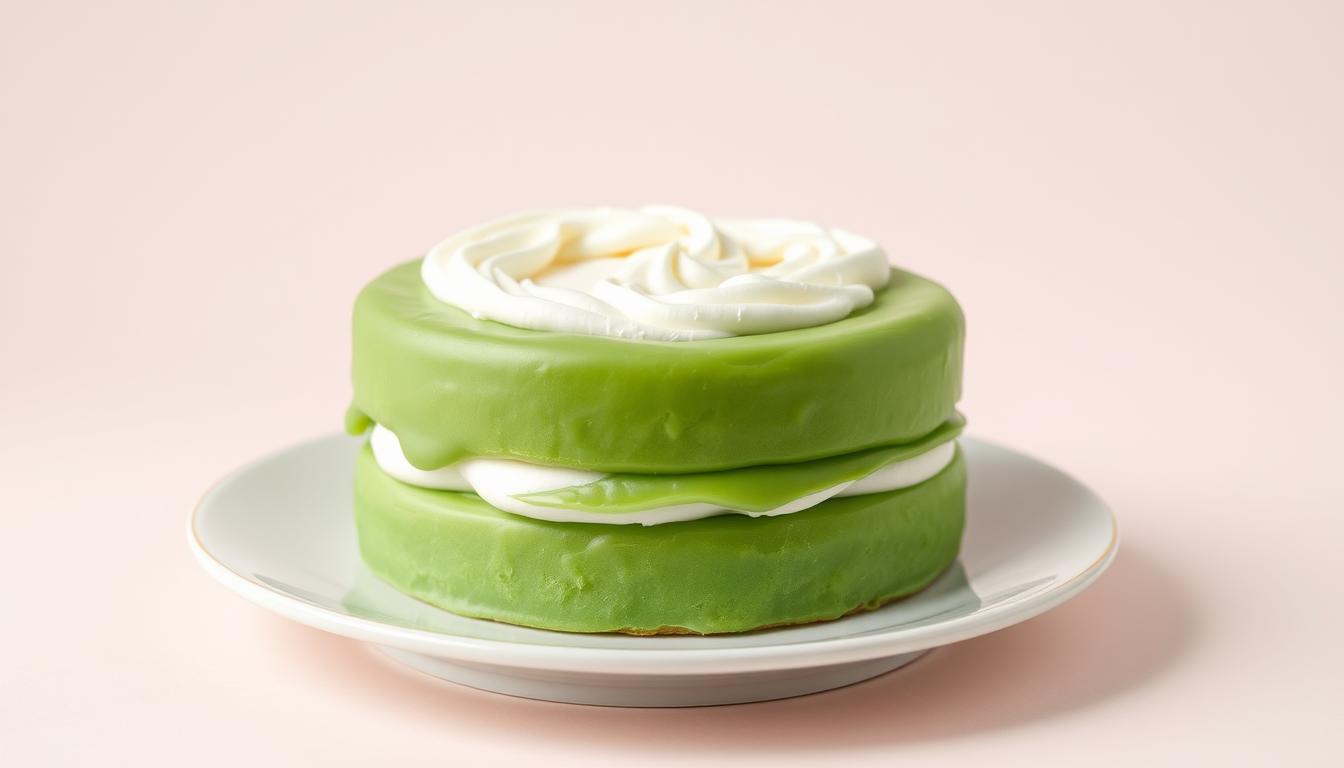Prep Time: 20 mins
Cook Time: 3 hrs 30 mins – 4 hrs
Total Time: 4 hrs – 4 hrs 30 mins
Servings: 4
Ingredients
- 4 pounds beef back ribs (about 2 ribs per person)
- 2 teaspoons smoked paprika
- 1 teaspoon garlic powder
- 1 teaspoon onion powder
- 1 teaspoon salt
- 1 teaspoon black pepper
- ½ cup barbecue sauce (or maple-bourbon, teriyaki, or keto-friendly alternative)
Directions
- Preheat oven to 275°F (135°C). Line a baking sheet with heavy-duty foil.
- Prepare ribs: Remove the thin membrane from the bone side of the ribs. Pat dry with paper towels.
- Season ribs: Mix paprika, garlic powder, onion powder, salt, and pepper. Rub generously over both sides of ribs.
- Wrap in foil: Place ribs bone-side up on the foil-lined baking sheet. Cover with a second sheet of foil and seal tightly.
- Bake: Cook in preheated oven for 3–4 hours, until meat pulls back about ¼ inch from the bone and a fork slides in easily.
- Add sauce: Carefully unwrap ribs, drain excess fat, and flip meat side up. Brush evenly with BBQ sauce.
- Broil: Set oven broiler to High. Place ribs 6 inches below heat. Broil 3–5 minutes, until sauce caramelizes.
Nutrition Facts (per serving)
Approximate values
Calories: 530 | Protein: 38g | Carbohydrates: 9g | Fat: 38g | Fiber: 1g | Sugar: 6g | Sodium: 720mg
Notes
- Don’t peek while baking — steam loss will dry out the ribs.
- For extra flavor, season and refrigerate ribs overnight before cooking.

Tips for Perfectly Tender Beef Baby Back Ribs
With the right approach, you can achieve tender and flavorful beef baby back ribs that will impress anyone. Cooking beef back ribs requires patience and understanding of the low slow cooking process.
Common Mistakes to Avoid
One of the most critical factors in cooking tender ribs is avoiding common mistakes. Don’t rush the cooking process by increasing the oven temperature, as this will result in tough meat. Instead, cook the ribs low and slow for at least 3-4 hours. Always place the ribs with the bone side facing the heat source initially to protect the delicate meat from drying out.
How to Tell When They’re Done
You can tell the ribs are done when the meat has shrunk back from the ends of the bones by about 1/4 inch. A toothpick or fork should easily penetrate the meat between the bones with little resistance. Another test is to pick up the rack with tongs; properly cooked ribs will bend easily.
Slow-Baked & Basted Beef Baby Back Ribs
Prep Time: 20 mins
Cook Time: 4 hrs 30 mins – 5 hrs
Total Time: 5 hrs – 5 hrs 30 mins
Servings: 4
Ingredients
- 4 pounds beef back ribs
- 2 teaspoons smoked paprika
- 1 teaspoon garlic powder
- 1 teaspoon onion powder
- 1 teaspoon salt
- 1 teaspoon black pepper
- Olive oil spray
- Smoked salt (optional, for extra flavor)
- Basting liquid:
- ½ cup apple cider vinegar
- 2 tablespoons hot sauce
- ½ cup barbecue sauce (or glaze of choice)
Directions
- Preheat oven to 250°F (121°C). Line a baking sheet with parchment.
- Prepare ribs: Remove membrane, pat dry, and season with paprika, garlic, onion powder, salt, and black pepper.
- Bake: Place ribs bone-side down on sheet. Spray tops with olive oil. Bake uncovered for 1 hour.
- Baste: Mix vinegar and hot sauce. After the first hour, baste ribs every hour for 3 hours (divide basting liquid into 3 portions).
- Finish baking: Continue cooking 4–5 hours total. Optionally reduce oven to 200°F (93°C) for the final hour for extra tenderness.
- Add sauce: In last 15 minutes, brush ribs with BBQ sauce or glaze.
- Broil: Broil 3–5 minutes until the sauce caramelizes.
Nutrition Facts (per serving)
Approximate values
Calories: 510 | Protein: 37g | Carbohydrates: 8g | Fat: 37g | Fiber: 1g | Sugar: 6g | Sodium: 710mg
Notes
Basting liquid can be customized with soy sauce, Worcestershire, or citrus juice.
This method creates a firmer texture than foil-wrapped ribs, with deeper smoky flavor from the basting liquid.

Conclusion
With the techniques outlined in this guide, you’re ready to impress with perfectly cooked beef baby back ribs. Both the foil-wrapped oven baking and slow bake with basting methods deliver exceptional results, making them accessible to cooks of all levels.
The key to tender ribs lies in patience and low, slow cooking. As you master these techniques, feel free to experiment with different dry rubs and sauces to create your signature beef rib recipe. Whether for a special occasion or a family dinner, your beef back ribs are sure to become a favorite, serving multiple servings with ease and pairing well with various sides.
Author’s Top Recipe Picks :
- Top 7 Incredible Beef Wellington Recipes You’ll Love
- 3 Perfect beef wellington cut of meat : The Ultimate Guide
- Ground Beef and Ramen: 4 Delicious Comfort Meal
Source Links
- Quick Beef Stir-Fry | thin sliced beef recipes – https://www.allrecipes.com/recipe/228823/quick-beef-stir-fry/
- 15 Best Shaved Beef Recipes You Must Try – https://thesavvymama.com/shaved-beef-recipes/
- Mongolian Beef (15 Minute Meal!)- Slender Kitchen – https://www.slenderkitchen.com/recipe/healthy-mongolian-beef




